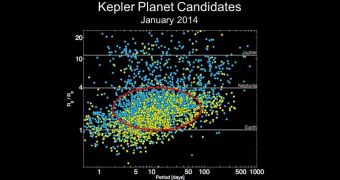Experts with the NASA Kepler space telescope science team presented new data from the observatory on Monday, January 6, at the American Astronomical Society meeting in Washington, DC. The group revealed that around 75 percent of all extrasolar planets discovered to date have sizes larger than Earth's and smaller than that of Neptune.
According to the team, most of the remaining worlds are larger than Neptune, and belong to the super-Neptune or hot-Jupiter classes, among others. A small number of these worlds are so large that they resemble small stars, and are called brown dwarfs.
However, most of the planets out there range in size from one to four Earth masses. Interestingly, astronomers cannot yet say for sure if these ancient worlds are made up of water, gas or rocks. It could be that a great degree of variability exists among these planets, the team said at the meeting.
The group also revealed more details of ground-based studies conducted over the past 4 years, since Kepler launched. Since hunting for planets is not easy, an entire system had to be devised where the telescope identifies candidates and marks their position, while ground-based observatories conduct long-term surveillance of those locations. Eventually, exoplanets are either confirmed or denied.
Thus far, Kepler has had a confirmation rate of nearly 90 percent, meaning that 9 out of 10 candidates it proposes turn out to be exoplanets. Seeing how the telescope's field of view contained 150,000 stars, and only around 3,500 worlds were discovered, we can expect to see data being released by the Kepler science team for years to come.
“This marvelous avalanche of information about the mini-Neptune planets is telling us about their core-envelope structure, not unlike a peach with its pit and fruit,” said University of California in Berkeley (UCB) professor of astronomy Geoff Marcy.
“We now face daunting questions about how these enigmas formed and why our solar system is devoid of the most populous residents in the galaxy,” adds the expert, who led an analysis that recently discovered five new exoplanets with amazing characteristics.
“Kepler's primary objective is to determine the prevalence of planets of varying sizes and orbits. Of particular interest to the search for life is the prevalence of Earth-sized planets in the habitable zone,” says NASA Ames Research Center mission scientist Natalie Batalha.
“But the question in the back of our minds is: are all planets the size of Earth rocky? Might some be scaled-down versions of icy Neptunes or steamy water worlds? What fraction are recognizable as kin of our rocky, terrestrial globe?” she concludes.

 14 DAY TRIAL //
14 DAY TRIAL //